Evolution of the Fracture Characteristics in a Rockburst under Different Stress Gradients
Abstract
:1. Introduction
2. Materials and Methods
2.1. Tested Material
2.2. Experimental Design
3. Results and Discussion
3.1. Rockburst Process Analysis
3.2. Analysis of Typical Rockburst Debris Fracture Surface Topography and Failure Mode
3.3. Analysis of Microscopic Surface Morphology and Failure Mode of Typical Rockburst Debris
3.4. Fracture Classification under Gradient Loading
3.4.1. Determination of the K-Value in the Acoustic Emission Characteristic Parameter Method Based on a Gaussian Mixture Model (GMM)
3.4.2. Failure Evolution Analysis of Rockburst Process in Test Model under Different Stress Gradients
4. Conclusions
Author Contributions
Funding
Institutional Review Board Statement
Informed Consent Statement
Data Availability Statement
Conflicts of Interest
References
- Ghorbani, M.; Shahriar, K.; Sharifzadeh, M.; Masoudi, R. A critical review on the developments of rock support systems in high stress ground conditions. Int. J. Rock Mech. Min. 2020, 30, 6–23. [Google Scholar] [CrossRef]
- Kim, J.S.; Lee, K.S.; Cho, W.J.; Choi, H.J.; Cho, G.C. A comparative evaluation of stress–strain and acoustic emission methods for quantitative damage assessments of brittle rock. Rock Mech. Rock Eng. 2015, 48, 495–508. [Google Scholar] [CrossRef]
- Adoko, A.C.; Gokceoglu, C.; Li, W.; Qing, J.Z. Knowledge-based and data-driven fuzzy modeling for rockburst prediction. Int. J. Rock Mech. Min. 2013, 61, 86–95. [Google Scholar] [CrossRef]
- Li, C.C.; Mikula, P.; Simser, B.; Hebblewhite, B.; Joughin, W.; Feng, X.; Xu, N. Discussions on rockburst and dynamic ground support in deep mines. J. Rock Mech. Geotech. 2019, 11, 1110–1118. [Google Scholar] [CrossRef]
- Borg, A.; Bjelland, H.; Nj, O. Reflections on Bayesian Network models for road tunnel safety design: A case study from Norway. Tunn. Undergr. Sp. Technol. 2014, 43, 300–314. [Google Scholar] [CrossRef]
- Afraei, S.; Shahriar, K.; Madani, S.H. Statistical assessment of rock burst potential and contributions of considered predictor variables in the task. Tunn. Undergr. Sp. Technol. 2018, 72, 250–271. [Google Scholar] [CrossRef]
- Yun, X.; Mitri, H.S.; Yang, X.L.; Wang, Y.K. Experimental investigation into biaxial compressive strength of granite. Int. J. Rock Mech. Min. 2010, 47, 334–341. [Google Scholar] [CrossRef]
- He, M.; Zhao, F.; Zhang, Y.; Du, S.; Guan, L. Feature evolution of dominant frequency components in acoustic emissions of instantaneous strain-type granitic rockburst simulation tests. Rock Soil Mech. 2015, 36, 1–8. [Google Scholar] [CrossRef]
- Akdag, S.; Karakus, M.; Taheri, A.; Nguyen, G.; Manchao, H. Effects of thermal damage on strain burst mechanism for brittle rocks under true-triaxial loading conditions. Rock Mech. Rock Eng. 2018, 56, 1657–1682. [Google Scholar] [CrossRef]
- Cheon, D.S.; Jeon, S.; Ryu, C. An experimental study on the brittle failure under true triaxial conditions. Tunn. Undergr. Sp. Technol. 2006, 21, 448–449. [Google Scholar] [CrossRef]
- Liu, X.; Xia, Y.; Lin, M.; Benzerzour, M. Experimental study of rockburst under true-triaxial gradient loading conditions. Geomech. Eng. 2019, 18, 481–492. [Google Scholar] [CrossRef]
- Liu, X.; Xia, Y.; Lin, M.; Wang, G.; Wang, D. Experimental study on the influence of tangential stress gradient on the energy evolution of strainburst. B. Eng. Geol. Environ. 2021, 80, 4515–4528. [Google Scholar] [CrossRef]
- Lin, M.; Zhang, L.; Liu, X.; Xia, Y.; Zhang, D.; Peng, Y. Microscopic analysis of rockburst failure on specimens under gradient stress. Rock Soil Mech. 2020, 41, 2984–2992. [Google Scholar] [CrossRef]
- Feng, S.; Gong, F.; Luo, Y.; Li, X.B. Experimental simulation on rockburst process of deep three-dimensional circular cavern. Rock Soil Mech. 2018, 39, 621–634. [Google Scholar] [CrossRef]
- Tao, M.; Ma, A.; Cao, W.; Li, X.; Gong, F. Dynamic response of pre-stressed rock with a circular cavity subject to transient loading. Int. J. Rock Mech. Min. 2017, 99, 1–8. [Google Scholar] [CrossRef]
- Roohollah, S.F.; Abbas, T. Long-term prediction of rockburst hazard in deep underground openings using three robust data mining techniques. Eng. Comput. 2019, 35, 659–675. [Google Scholar] [CrossRef]
- Zhou, Y.; Sun, Z.; Wang, L.; Ding, Y. Meso research on mechanical properties and slab failure mechanism of pre-fractured rock mass under the condition of one side restriction loading. Rock Soil Mech. 2018, 39, 4385–4394. [Google Scholar] [CrossRef]
- He, M.; Nie, W.; Han, L.; Ling, L. Microcrack analysis of Sanya grantite fragments from rockburst tests. Min. Sci. Technol. 2010, 20, 238–243. [Google Scholar] [CrossRef]
- Li, H.; Huang, R. Method of quantitative determination of joint roughness coefficient. Chin. J. Rock Mech. Eng. 2014, 33, 3489–3497. [Google Scholar] [CrossRef]
- Shiotani, T.; Shigeishi, M.; Ohtsu, M. Acoustic emission characteristics of concrete-piles. Constr. Build. Mater. 1999, 13, 73–85. [Google Scholar] [CrossRef]
- Yoon, S.J.; Chen, D.; Han, S.W.; Choi, N.S.; Arakawa, K. AE analysis of delamination crack propagation in carbon fiber-reinforced polymer materials. J. Mech. Sci. Technol. 2015, 29, 17–21. [Google Scholar] [CrossRef]
- Ichenihi, A.; Li, W.; Gao, Y.; Yao, Y. Feature selection and clustering of damage for pseudo-ductile unidirectional carbon/glass hybrid composite using acoustic emission. Appl. Acoust. 2021, 182, 108184. [Google Scholar] [CrossRef]
- Kittel, M.; Hobbie, H.; Dierstein, C.; Lund, H.; Kaiser, M.J. Temporal aggregation of time series to identify typical hourly electricity system states: A systematic assessment of relevant cluster algorithms. Energy 2022, 247, 123458. [Google Scholar] [CrossRef]
- Ohno, K.; Ohtsu, M. Crack classification in concrete based on acoustic emission. Constr. Build. Mater. 2010, 24, 2339–2346. [Google Scholar] [CrossRef]
- Wang, G.; Song, L.; Liu, X.; Bao, C.Y.; Lin, M.Q.; Liu, G.J. Shear fracture mechanical properties and acoustic emission characteristics of discontinuous jointed granite. Rock Soil Mech. 2022, 43, 1533–1545. [Google Scholar] [CrossRef]
- Shiotani, T.; Ohtsu, M.; Ikeda, K. Detection and evaluation of AE waves due to rock deformation. Constr. Build. Mater. 2001, 15, 235–246. [Google Scholar] [CrossRef]
- Song, L.; Wang, G.; Wang, X.; Huang, M.; Xu, K.; Han, G.; Liu, G. The influence of joint inclination and opening width on fracture characteristics of granite under triaxial compression. Int. J. Geomech. 2022, 22, 04022031. [Google Scholar] [CrossRef]
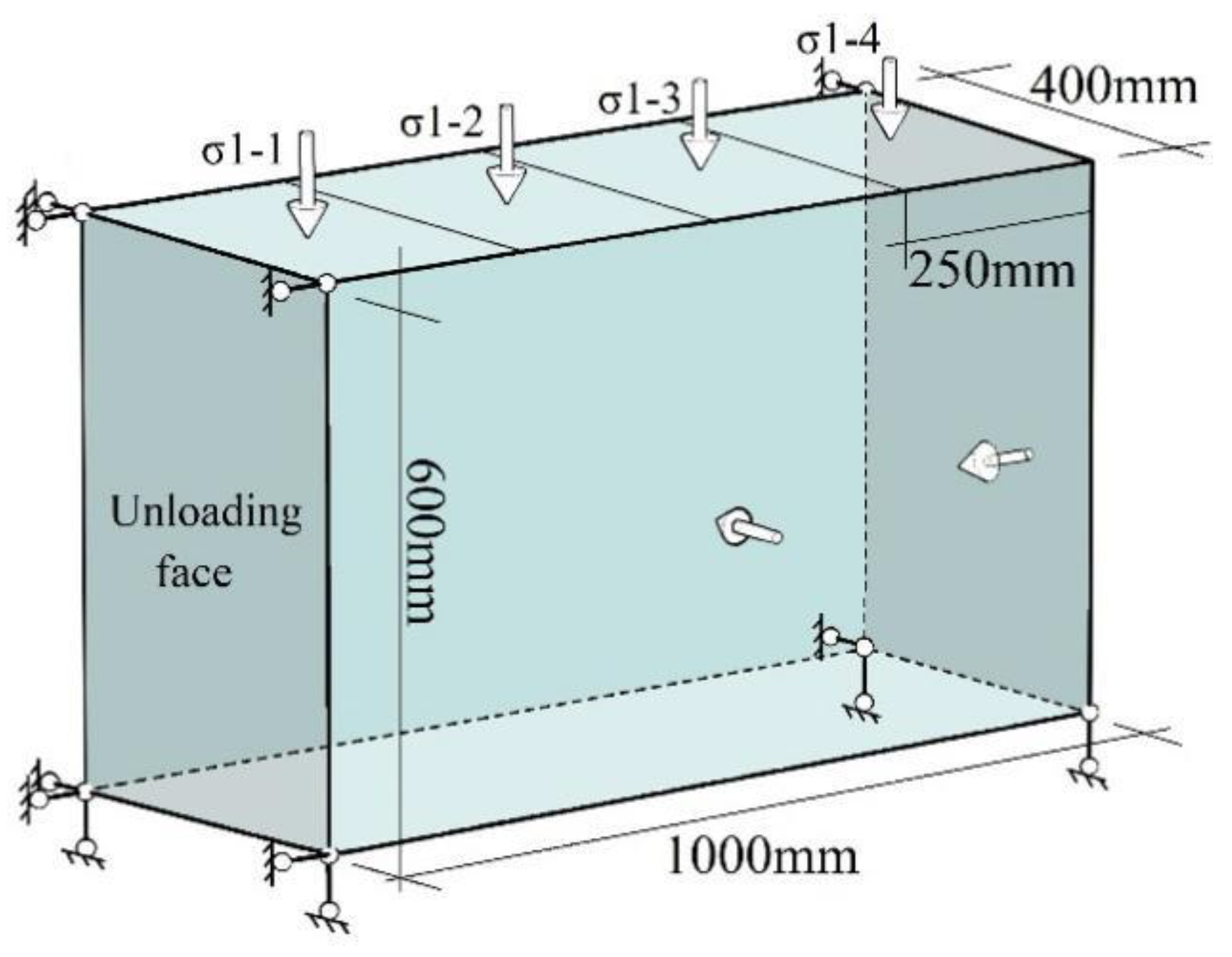
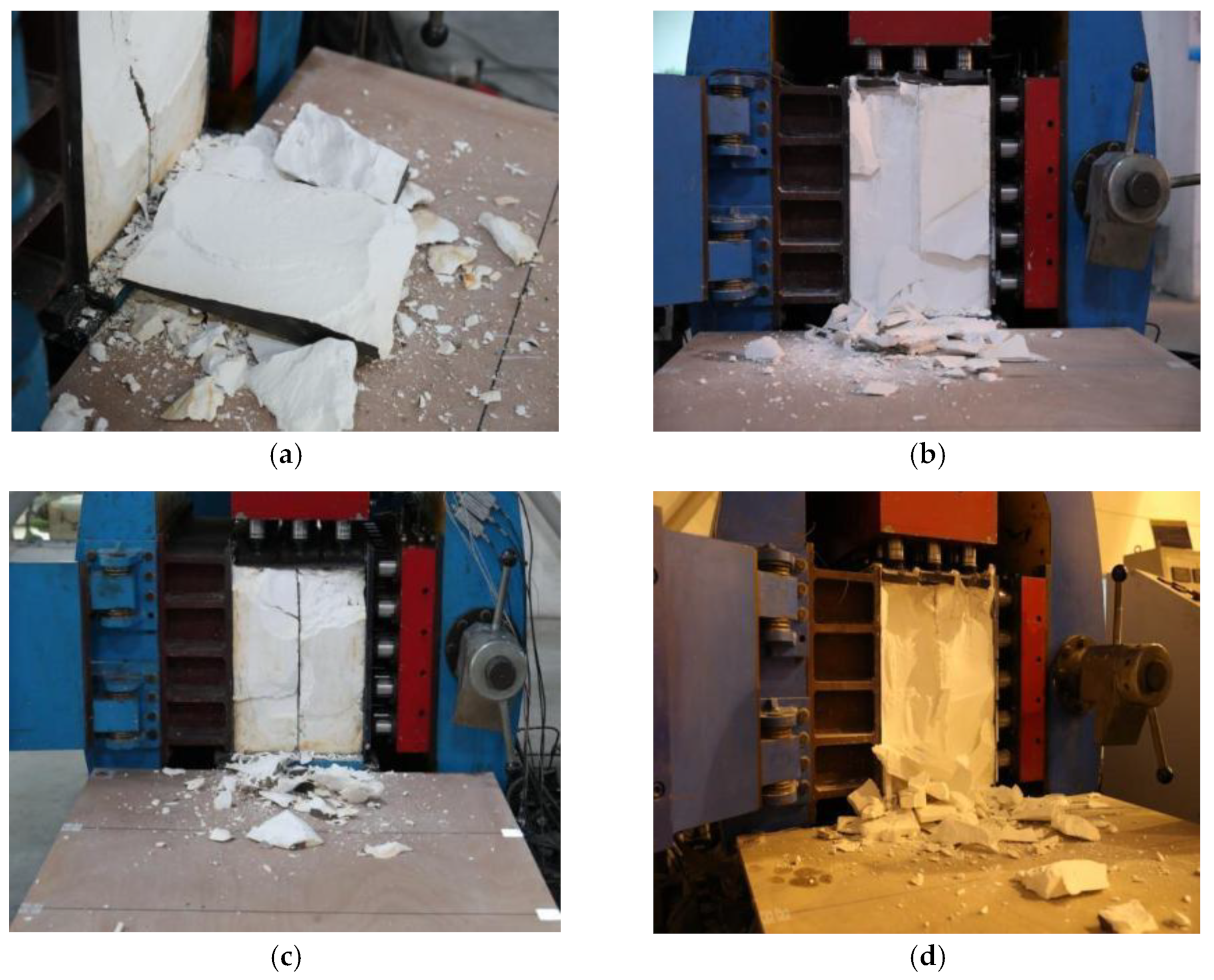



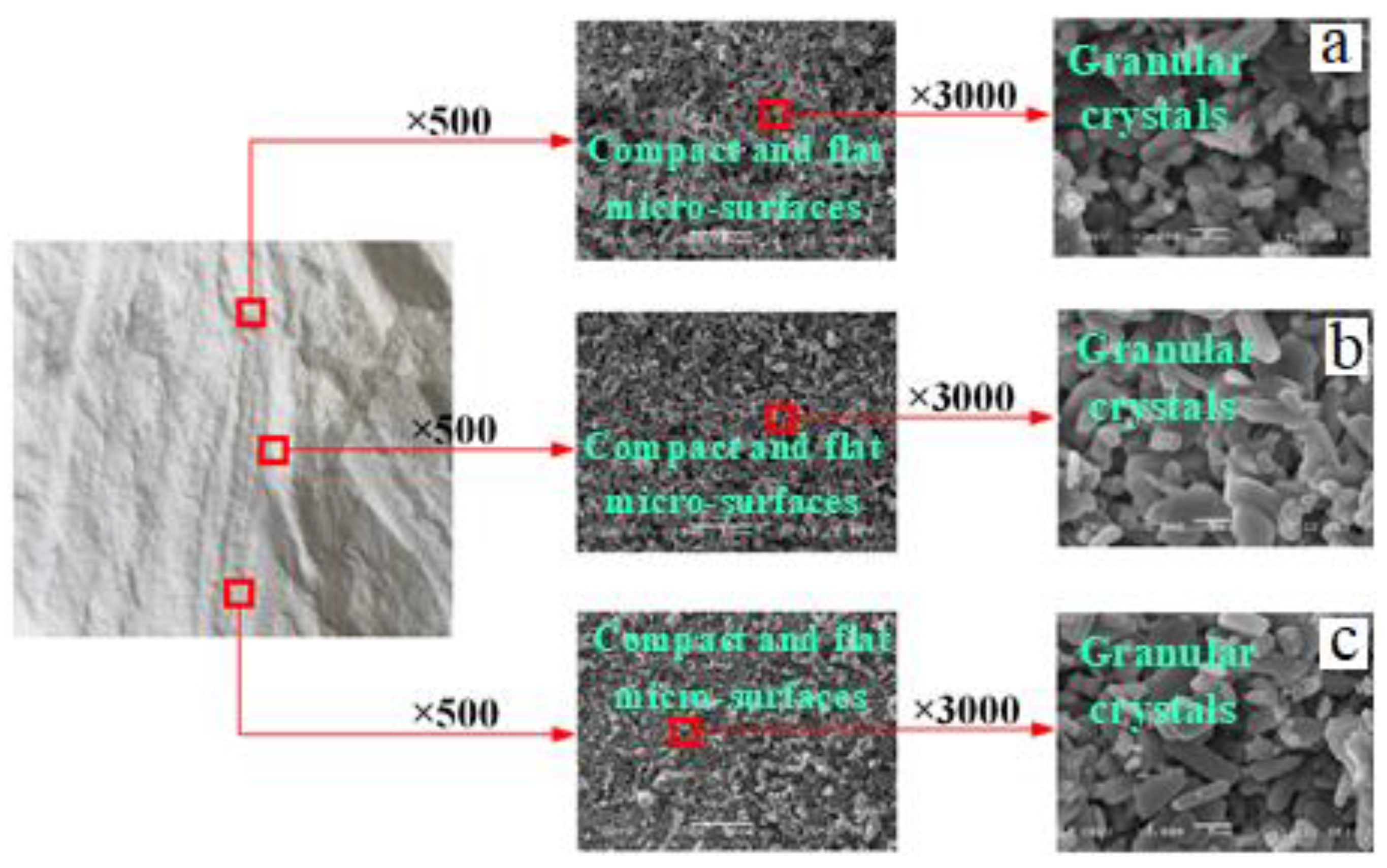
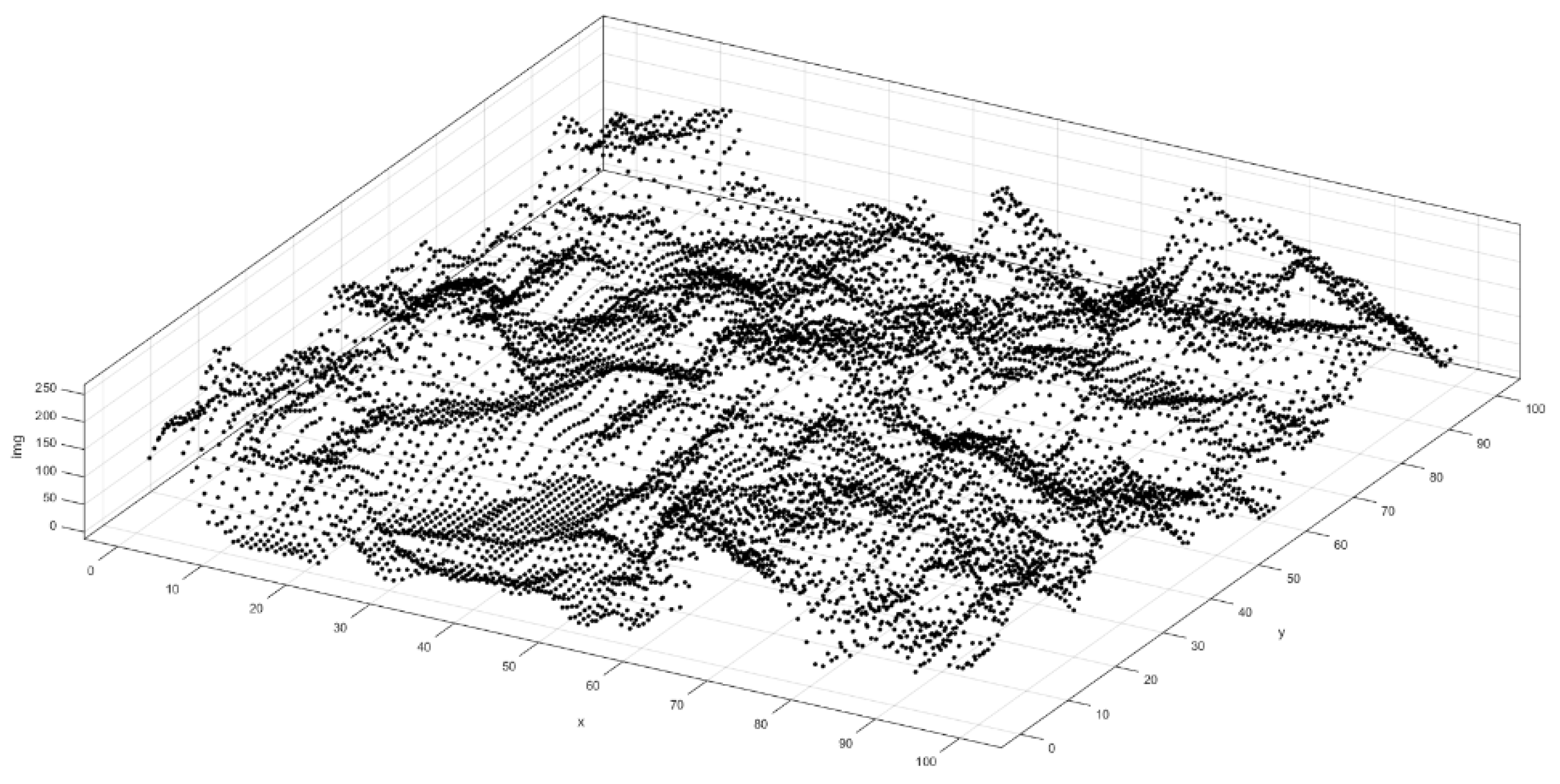
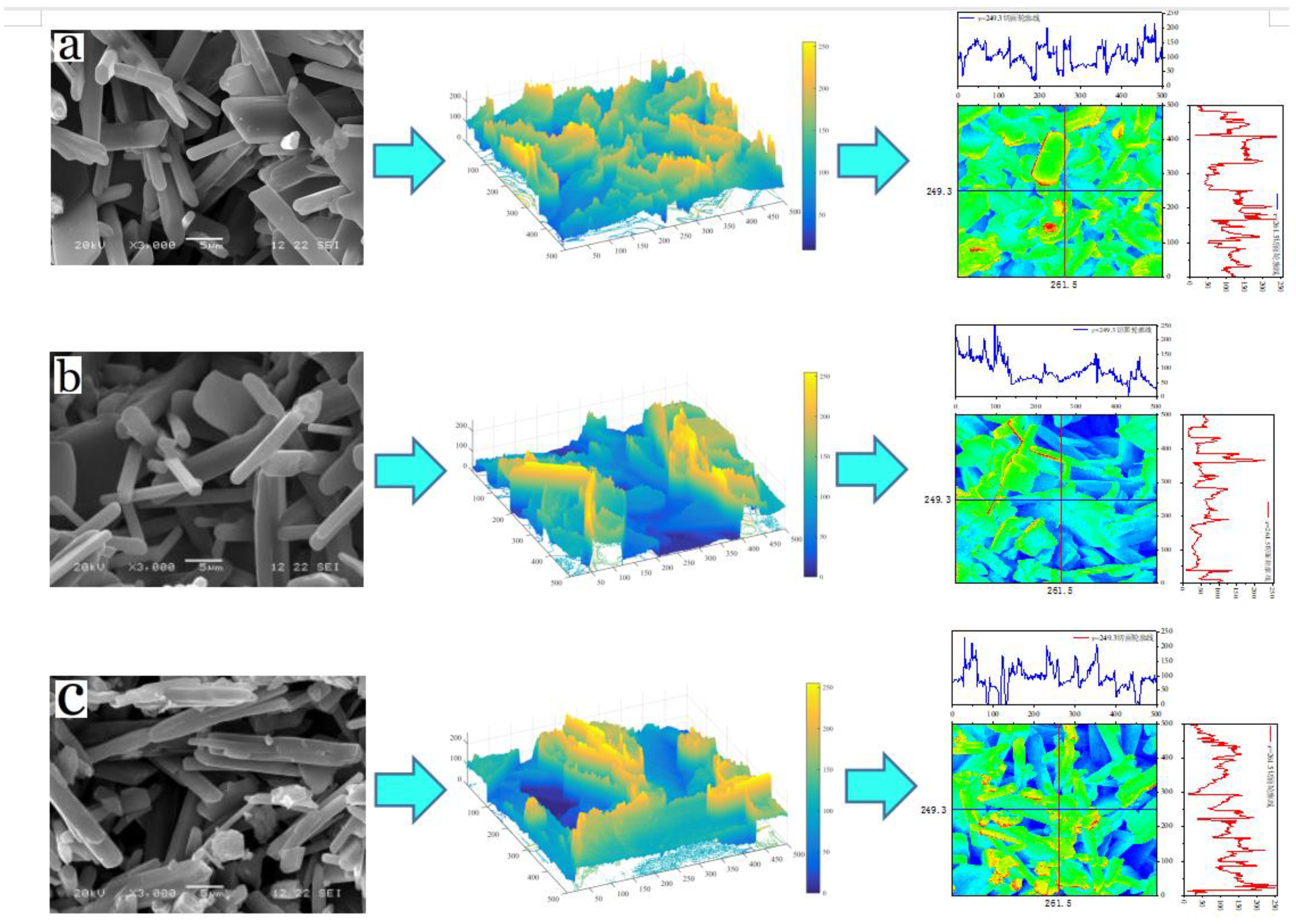
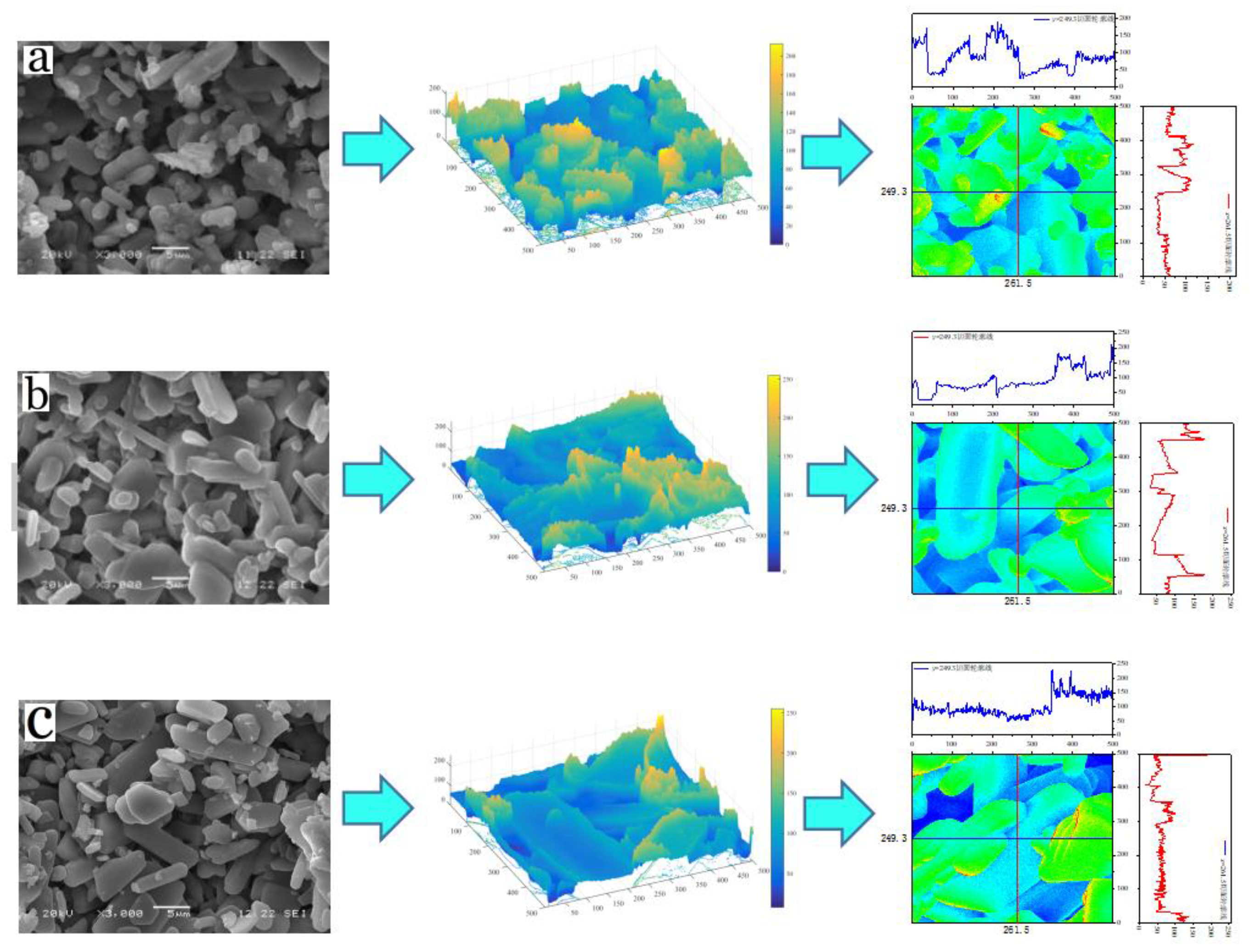
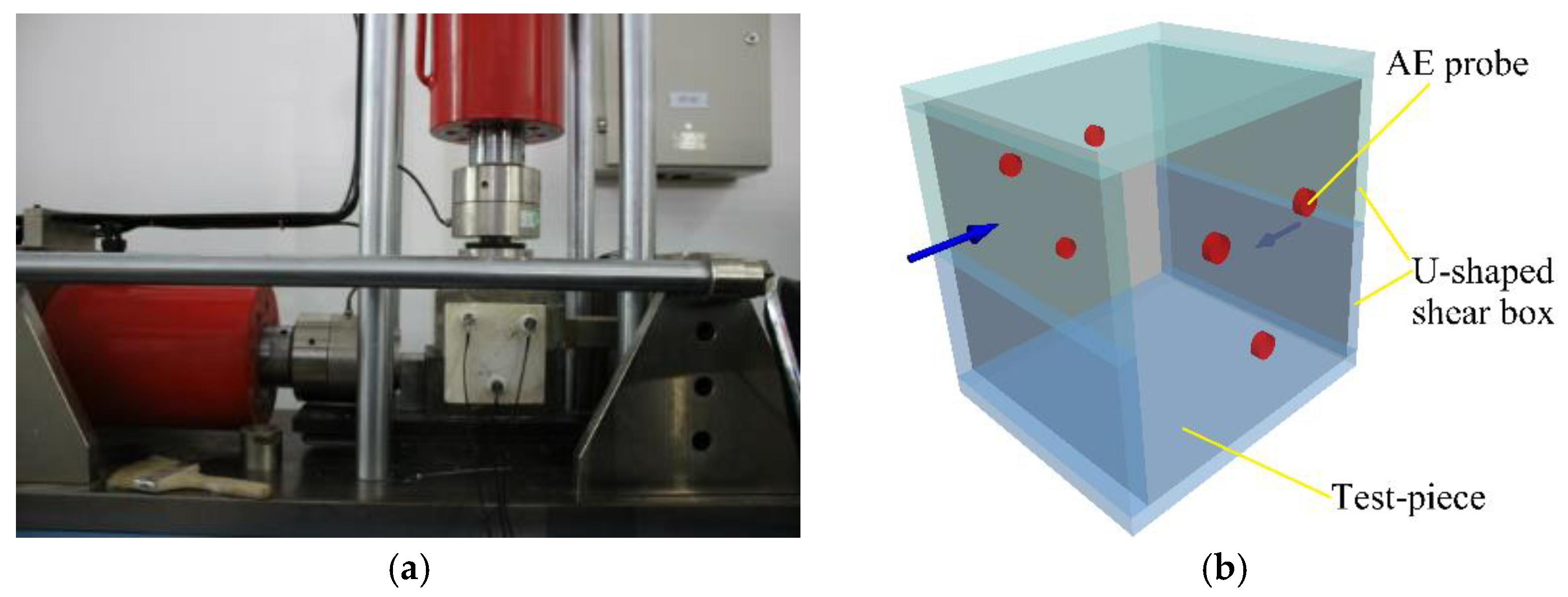
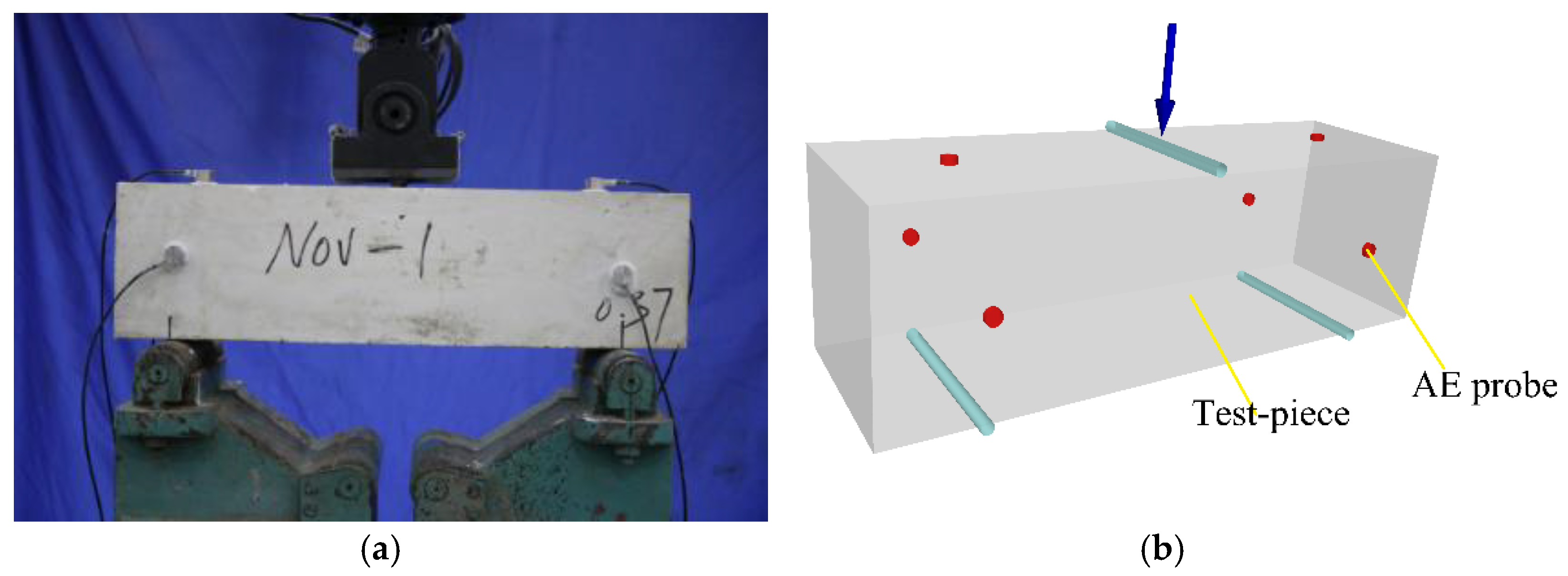
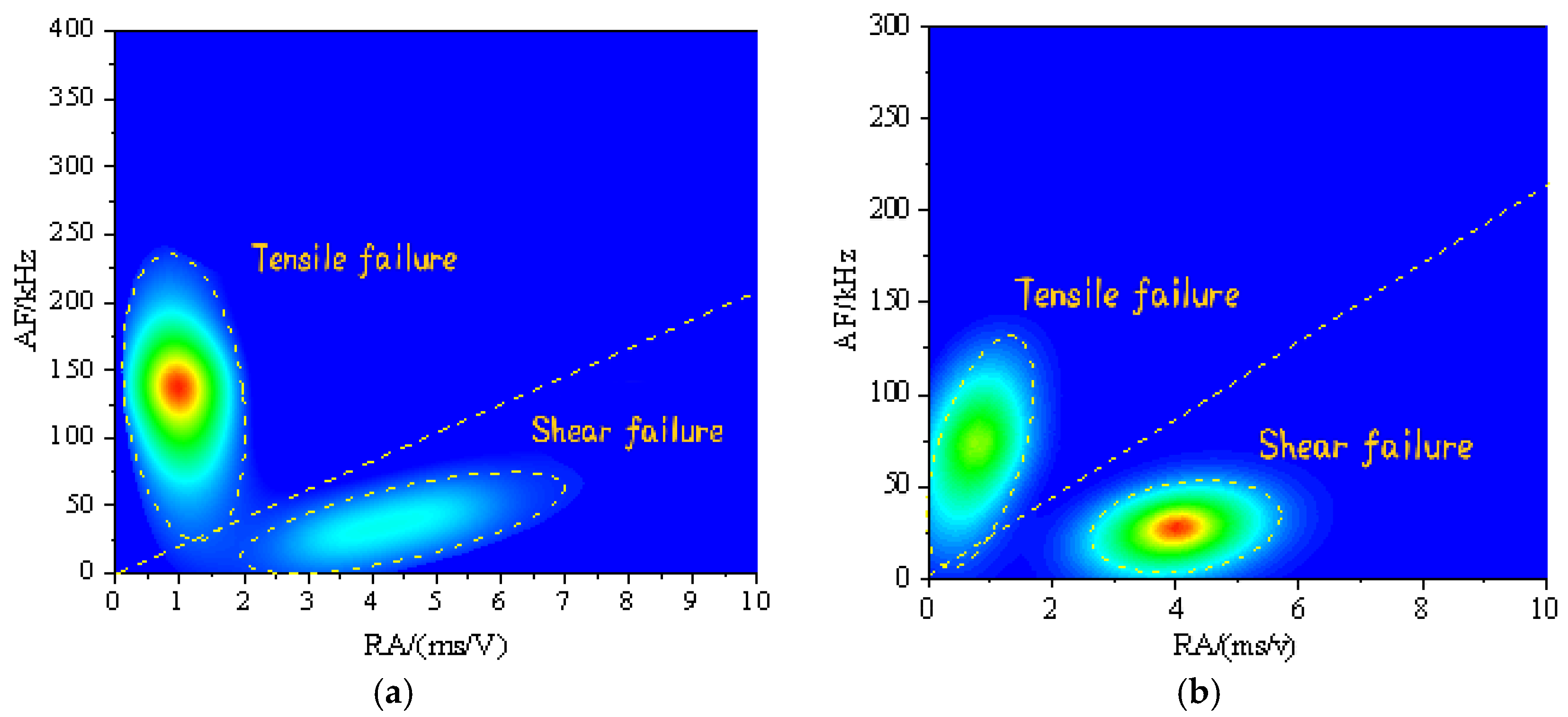
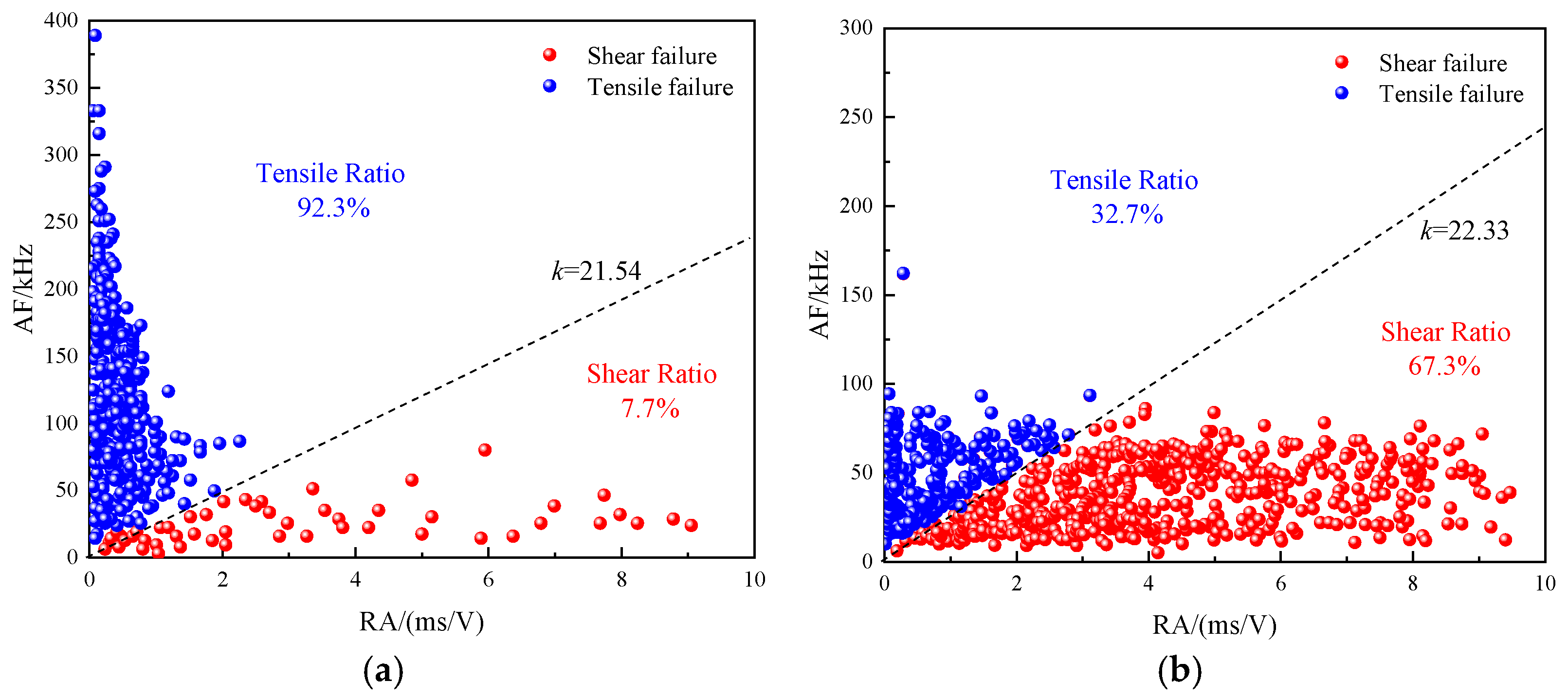
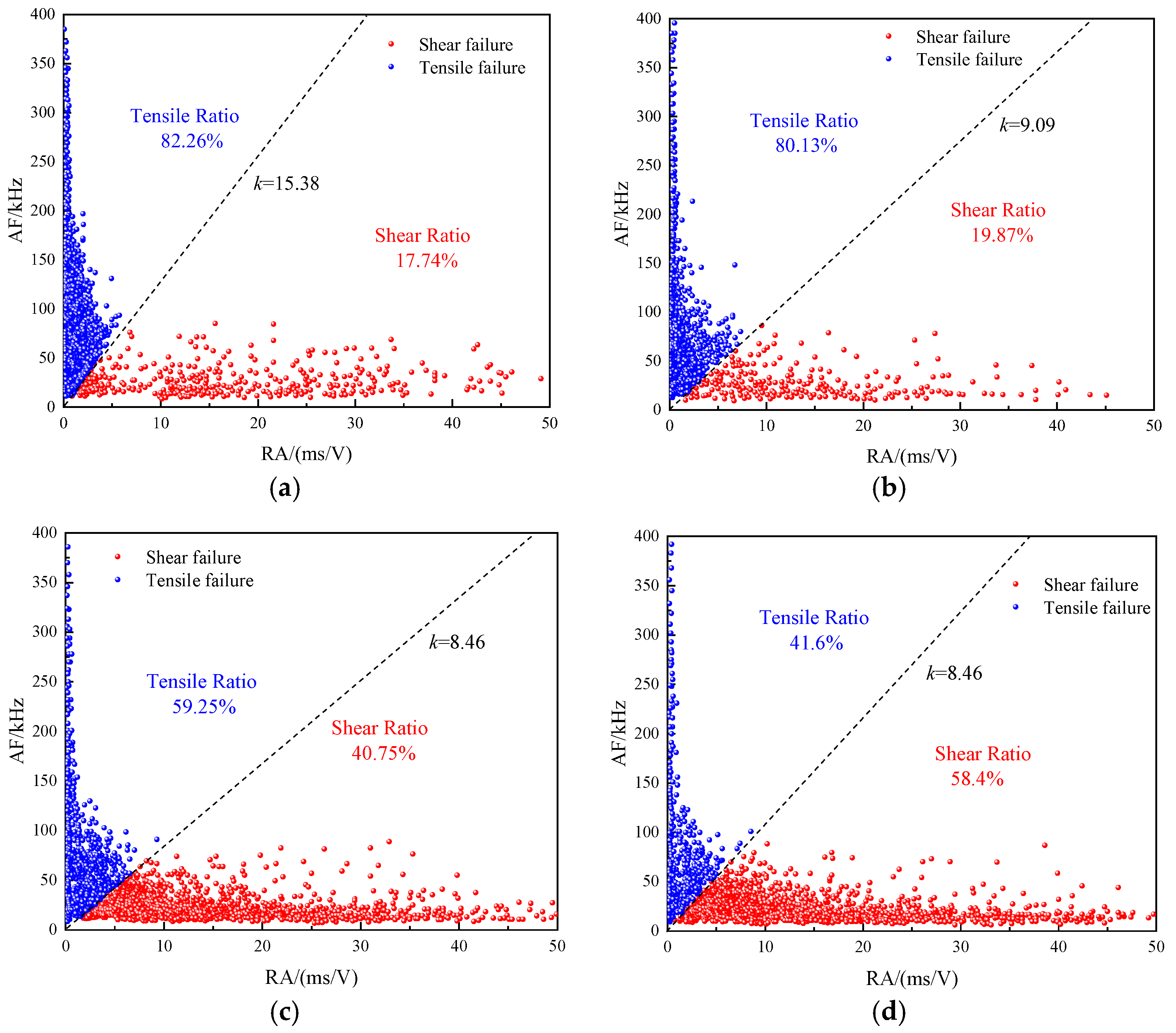
| Material | Water/Gypsum Ratio | Poisson’s Ratio | Elastic Modulus/GPa | σc/MPa | Wet |
|---|---|---|---|---|---|
| Gypsum | 0.7 | 0.25 | 1.268 | 9.2 | 10.15 |
| Stress Gradient | Rockburst Failure Phenomenon Description | Debris Morphology and Maximum Throw Distance |
|---|---|---|
| m = 0 | Before the failure of the model, small particles were catapulted, followed by a large noise, and huge plate-like debris on the unloading surface was released, stripped and broken, and then fell off. | Thick plate-like and sheet-like debris distributed within 0.5 m of the unloading surface. |
| m = 2 | Two obvious fine particles ejected from the top of the model, followed by flake debris peeling and popping out. The peeling phenomenon was serious, and a small amount of ejection occurred. The debris was scaly and exfoliated. | Flake and block debris distributed within 0.7 m of the unloading surface. |
| m = 4 | A large amount of debris on the top of the model was continuously catapulted, and finally a large flake bending and ejection failure occurred on the upper part, accompanied by violent sound, and a large amount of ejection or dynamic falling. | Bulk and lenticular debris, debris up to 1.5 m thrown distance. |
| m = 6 | In the absence of obvious precursor failure, an “explosive” rockburst occurred in the middle and lower part of the model, and a large volume of wedge-shaped debris flew out at a high speed, forming a cave-shaped rockburst pit. | Wedge-shaped, block-shaped debris with a maximum throw distance of 2.0 m. |
| Debris Morphology | Measurement Area | JRC (x-Direction) | JRC (y-Direction) |
|---|---|---|---|
| Plate and flake debris Micro-fracture surface | a | 19.3 | 19.7 |
| b | 19.5 | 19.2 | |
| c | 19.5 | 19.8 | |
| Massive and lenticular debris micro-fracture surface | a | 16.5 | 17.1 |
| b | 16.8 | 17.3 | |
| c | 17.5 | 16.3 |
| Loading Stress Gradient Coefficient | Fracture Classification K-Values | Proportion of Tensile Failures | Proportion of Shear Failures |
|---|---|---|---|
| m = 0 | 15.38 | 82.26% | 17.74% |
| m = 2 | 9.09 | 80.13% | 19.87% |
| m = 4 | 8.46 | 59.25% | 40.75% |
| m = 6 | 11.03 | 41.6% | 58.4% |
Publisher’s Note: MDPI stays neutral with regard to jurisdictional claims in published maps and institutional affiliations. |
© 2022 by the authors. Licensee MDPI, Basel, Switzerland. This article is an open access article distributed under the terms and conditions of the Creative Commons Attribution (CC BY) license (https://creativecommons.org/licenses/by/4.0/).
Share and Cite
Yang, S.; Gao, Y.; Liu, X.; Wang, G.; Song, L.; Bao, C. Evolution of the Fracture Characteristics in a Rockburst under Different Stress Gradients. Buildings 2022, 12, 1927. https://doi.org/10.3390/buildings12111927
Yang S, Gao Y, Liu X, Wang G, Song L, Bao C. Evolution of the Fracture Characteristics in a Rockburst under Different Stress Gradients. Buildings. 2022; 12(11):1927. https://doi.org/10.3390/buildings12111927
Chicago/Turabian StyleYang, Shuaidong, Yueming Gao, Xiqi Liu, Gang Wang, Leibo Song, and Chunyan Bao. 2022. "Evolution of the Fracture Characteristics in a Rockburst under Different Stress Gradients" Buildings 12, no. 11: 1927. https://doi.org/10.3390/buildings12111927
APA StyleYang, S., Gao, Y., Liu, X., Wang, G., Song, L., & Bao, C. (2022). Evolution of the Fracture Characteristics in a Rockburst under Different Stress Gradients. Buildings, 12(11), 1927. https://doi.org/10.3390/buildings12111927











